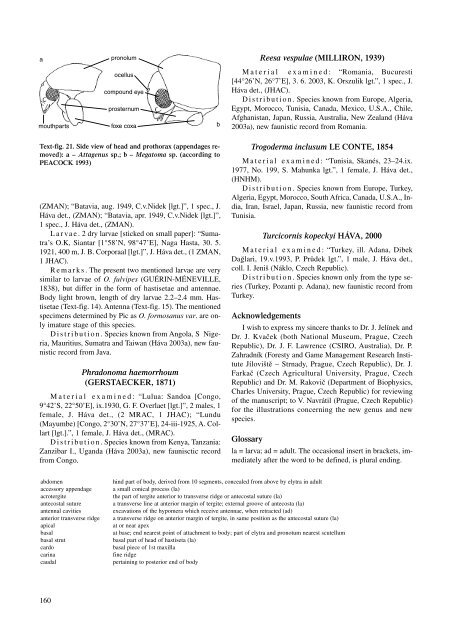world keys to the genera and subgenera of dermestidae (coleoptera)
world keys to the genera and subgenera of dermestidae (coleoptera)
world keys to the genera and subgenera of dermestidae (coleoptera)
You also want an ePaper? Increase the reach of your titles
YUMPU automatically turns print PDFs into web optimized ePapers that Google loves.
a<br />
Text-fig. 21. Side view <strong>of</strong> head <strong>and</strong> prothorax (appendages removed):<br />
a – Attagenus sp.; b – Mega<strong>to</strong>ma sp. (according <strong>to</strong><br />
PEACOCK 1993)<br />
(ZMAN); “Batavia, aug. 1949, C.v.Nidek [lgt.]”, 1 spec., J.<br />
Háva det., (ZMAN); “Batavia, apr. 1949, C.v.Nidek [lgt.]”,<br />
1 spec., J. Háva det., (ZMAN).<br />
Larvae. 2 dry larvae [sticked on small paper]: “Sumatra’s<br />
O.K, Siantar [1°58’N, 98°47’E], Naga Hasta, 30. 5.<br />
1921, 400 m, J. B. Corporaal [lgt.]”, J. Háva det., (1 ZMAN,<br />
1 JHAC).<br />
Remarks. The present two mentioned larvae are very<br />
similar <strong>to</strong> larvae <strong>of</strong> O. fulvipes (GUÉRIN-MÉNEVILLE,<br />
1838), but differ in <strong>the</strong> form <strong>of</strong> hastisetae <strong>and</strong> antennae.<br />
Body light brown, length <strong>of</strong> dry larvae 2.2–2.4 mm. Hastisetae<br />
(Text-fig. 14). Antenna (Text-fig. 15). The mentioned<br />
specimens determined by Pic as O. formosanus var. are only<br />
imature stage <strong>of</strong> this species.<br />
Distribution. Species known from Angola, S Nigeria,<br />
Mauritius, Sumatra <strong>and</strong> Taiwan (Háva 2003a), new faunistic<br />
record from Java.<br />
Phradonoma haemorrhoum<br />
(GERSTAECKER, 1871)<br />
Material examined: “Lulua: S<strong>and</strong>oa [Congo,<br />
9°42’S, 22°50’E], ix.1930, G. F. Overlaet [lgt.]”, 2 males, 1<br />
female, J. Háva det., (2 MRAC, 1 JHAC); “Lundu<br />
(Mayumbe) [Congo, 2°30’N, 27°37’E], 24-iii-1925, A. Collart<br />
[lgt.].”, 1 female, J. Háva det., (MRAC).<br />
Distribution. Species known from Kenya, Tanzania:<br />
Zanzibar I., Ug<strong>and</strong>a (Háva 2003a), new faunisctic record<br />
from Congo.<br />
160<br />
b<br />
Reesa vespulae (MILLIRON, 1939)<br />
Material examined: “Romania, Bucuresti<br />
[44°26’N, 26°7’E], 3. 6. 2003, K. Orszulik lgt.”, 1 spec., J.<br />
Háva det., (JHAC).<br />
Distribution. Species known from Europe, Algeria,<br />
Egypt, Morocco, Tunisia, Canada, Mexico, U.S.A., Chile,<br />
Afghanistan, Japan, Russia, Australia, New Zeal<strong>and</strong> (Háva<br />
2003a), new faunistic record from Romania.<br />
Trogoderma inclusum LE CONTE, 1854<br />
Material examined: “Tunisia, Skanés, 23–24.ix.<br />
1977, No. 199, S. Mahunka lgt.”, 1 female, J. Háva det.,<br />
(HNHM).<br />
Distribution. Species known from Europe, Turkey,<br />
Algeria, Egypt, Morocco, South Africa, Canada, U.S.A., India,<br />
Iran, Israel, Japan, Russia, new faunistic record from<br />
Tunisia.<br />
Turcicornis kopeckyi HÁVA, 2000<br />
Material examined: “Turkey, ill. Adana, Dibek<br />
Dag˘lari, 19.v.1993, P. Průdek lgt.”, 1 male, J. Háva det.,<br />
coll. I. Jeniš (Náklo, Czech Republic).<br />
Distribution. Species known only from <strong>the</strong> type series<br />
(Turkey, Pozanti p. Adana), new faunistic record from<br />
Turkey.<br />
Acknowledgements<br />
I wish <strong>to</strong> express my sincere thanks <strong>to</strong> Dr. J. Jelínek <strong>and</strong><br />
Dr. J. Kvaček (both National Museum, Prague, Czech<br />
Republic), Dr. J. F. Lawrence (CSIRO, Australia), Dr. P.<br />
Zahradník (Foresty <strong>and</strong> Game Management Research Institute<br />
Jíloviště – Strnady, Prague, Czech Republic), Dr. J.<br />
Farkač (Czech Agricultural University, Prague, Czech<br />
Republic) <strong>and</strong> Dr. M. Rakovič (Department <strong>of</strong> Biophysics,<br />
Charles University, Prague, Czech Republic) for reviewing<br />
<strong>of</strong> <strong>the</strong> manuscript; <strong>to</strong> V. Navrátil (Prague, Czech Republic)<br />
for <strong>the</strong> illustrations concerning <strong>the</strong> new genus <strong>and</strong> new<br />
species.<br />
Glossary<br />
la = larva; ad = adult. The occasional insert in brackets, immediately<br />
after <strong>the</strong> word <strong>to</strong> be defined, is plural ending.<br />
abdomen hind part <strong>of</strong> body, derived from 10 segments, concealed from above by elytra in adult<br />
accessory appendage a small conical process (la)<br />
acrotergite <strong>the</strong> part <strong>of</strong> tergite anterior <strong>to</strong> transverse ridge or antecostal suture (la)<br />
antecostal suture a transverse line at anterior margin <strong>of</strong> tergite; external groove <strong>of</strong> antecosta (la)<br />
antennal cavities excavations <strong>of</strong> <strong>the</strong> hypomera which receive antennae, when retracted (ad)<br />
anterior transverse ridge a transverse ridge on anterior margin <strong>of</strong> tergite, in same position as <strong>the</strong> antecostal suture (la)<br />
apical at or near apex<br />
basal at base; end nearest point <strong>of</strong> attachment <strong>to</strong> body; part <strong>of</strong> elytra <strong>and</strong> pronotum nearest scutellum<br />
basal strut basal part <strong>of</strong> head <strong>of</strong> hastiseta (la)<br />
cardo basal piece <strong>of</strong> 1st maxilla<br />
carina fine ridge<br />
caudal pertaining <strong>to</strong> posterior end <strong>of</strong> body


